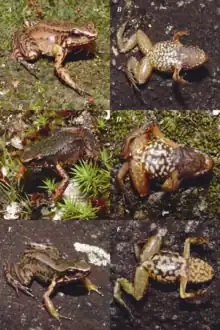Aromobates
Aromobates, sometimes known as the skunk frogs, is a genus of frogs from the Andes of Venezuela and Colombia. Originally a monotypic genus consisting of the skunk frog, Aromobates nocturnus alone, it was later[1] expanded to include Nephelobates. These frogs are difficult to differentiate from Allobates without using molecular markers.[2]
| Aromobates | |
|---|---|
 | |
| Aromobates ornatissimus | |
| Scientific classification | |
| Domain: | Eukaryota |
| Kingdom: | Animalia |
| Phylum: | Chordata |
| Class: | Amphibia |
| Order: | Anura |
| Family: | Aromobatidae |
| Subfamily: | Aromobatinae |
| Genus: | Aromobates Myers, Paolillo-O., and Daly, 1991 |
| Type species | |
| Aromobates nocturnus Myers, Paolillo-O., and Daly, 1991 | |
| Diversity | |
| 18 species (see text) | |
| Synonyms | |
|
Nephelobates La Marca, 1994 | |
Etymology
The generic name derives from the Latin aroma, meaning "sweet odor".[3] The odor of the type species, Aromobates nocturnus, is reminiscent of a skunk.[4][5]
Description
Aromobates are small to medium-sized frogs that have cryptic colouration. They have robust body form and basal to extensive toe webbing. For example, the relatively small Aromobates meridensis and Aromobates walterarpi are around 3 cm (1.2 in) in snout–vent length and have basal webbing only, whereas the relatively large Aromobates nocturnus (up to 62 mm (2.4 in) SVL in females) have webbed feet.[5]
Species
There are 18 species,[2] many of them endangered:[6]
- Aromobates alboguttatus (Boulenger, 1903) (Possibly Extinct)
- Aromobates cannatellai Barrio-Amorós and Santos, 2012
- Aromobates capurinensis (Péfaur, 1993)
- Aromobates duranti (Péfaur, 1985) (Critically Endangered)
- Aromobates ericksonae Barrio-Amorós and Santos, 2012
- Aromobates haydeeae (Rivero, 1978) (Possibly Extinct)
- Aromobates leopardalis (Rivero, 1978) (Possibly Extinct)
- Aromobates mayorgai (Rivero, 1980) (Endangered)
- Aromobates meridensis (Dole and Durant, 1972) (Critically Endangered)
- Aromobates molinarii (La Marca, 1985) (Critically Endangered)
- Aromobates nocturnus Myers, Paolillo-O., and Daly, 1991 (Critically Endangered)
- Aromobates ornatissimus Barrio-Amorós, Rivero, and Santos, 2011
- Aromobates orostoma (Rivero, 1978) (Critically Endangered)
- Aromobates saltuensis (Rivero, 1980) (Endangered)
- Aromobates serranus (Péfaur, 1985) (Possibly Extinct)
- Aromobates tokuko Rojas-Runjaic, Infante-Rivero, and Barrio-Amorós, 2011
- Aromobates walterarpi La Marca and Otero-López, 2012
- Aromobates zippeli Barrio-Amorós and Santos, 2012
References
- Grant, T.; Frost, D. R.; Caldwell, J. P.; Gagliardo, R.; Haddad, C. F. B.; Kok, P. J. R.; Means, D. B.; Noonan, B. P.; Schargel, W. E. & Wheeler, W. (2006). "Phylogenetic systematics of dart-poison frogs and their relatives (Amphibia, Athesphatanura, Dendrobatidae)" (PDF). Bulletin of the American Museum of Natural History. 299: 1–262. doi:10.1206/0003-0090(2006)299[1:psodfa]2.0.co;2. hdl:2246/5803. S2CID 82263880.
- Frost, Darrel R. (2014). "Aromobates Myers, Paolillo-O., and Daly, 1991". Amphibian Species of the World: an Online Reference. Version 6.0. American Museum of Natural History. Retrieved 15 August 2014.
- "aroma". Online Etymology Dictionary. Douglas Harper.
- F. Harvey Pough; et al. (2004). Herpetology. Upper Saddle River, NJ: Pearson/Prentice Hall. p. 92. ISBN 0-13-100849-8.
- Vitt, Laurie J.; Caldwell, Janalee P. (2014). Herpetology: An Introductory Biology of Amphibians and Reptiles (4th ed.). Academic Press. p. 487.
- IUCN (2014). "IUCN Red List of Threatened Species. Version 2014.2. <www.iucnredlist.org>". Retrieved 15 August 2014.